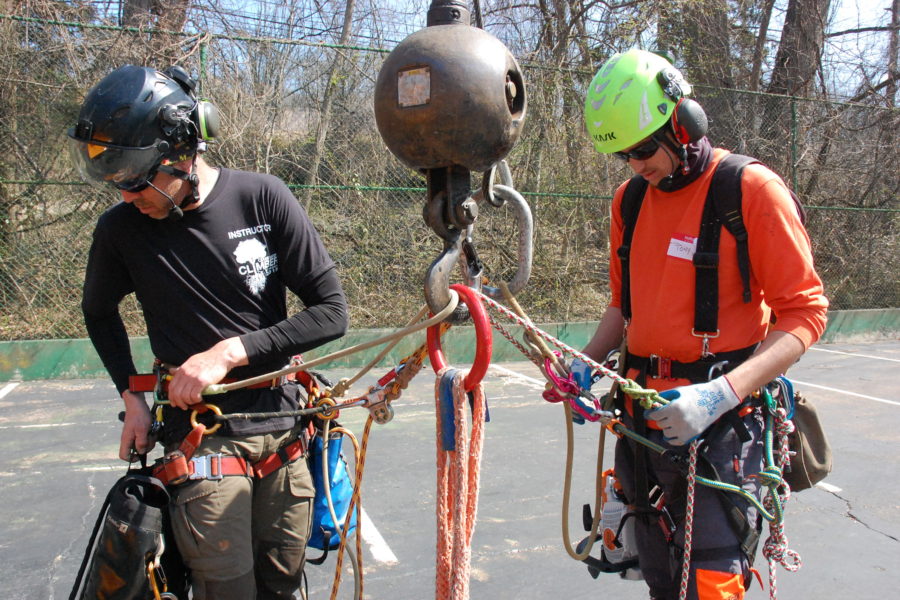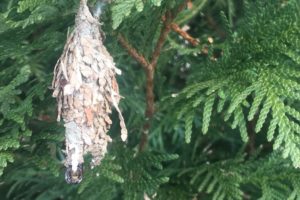Rob Thigpen is tied into the crane ball across from me as we rest hip to hip, checking our climbing hitches and lanyards. We acknowledge that we are secured and ready and the crane cable tightens and removes us from the surface of the earth as Dave Swirdsding lifts us over one-hundred feet into the air high above a Tulip poplar with his fifty-ton swing cab crane.
Rob and I make small talk about work and life and before I know it he’s already repelled off the ball and secured himself into the neighboring leader next to the one I am about to rig with the braided slings. Dave Swirdsding’s comforting voice travels through our bluetooth connection and assures me he’s good for three thousand pounds as I stare down at the intertwining branches of the tree, imagining how I’ll place my slings in order to balance the massive branch. My heart begins to beat faster as I grab my hitch and break it and descend into the branch’s center of gravity.
In moments like these, that beautiful concept of balance comes to define everything.
Rob coaches me over my shoulder as I tie my slings; cow hitch, timber hitch, cow hitch. Far below, I can feel Jim Roach’s critique with the rest of students rising upward through the peppery smell of Tulip poplar branches that were destroyed in the chipper from the last pick.
After the slings are placed, Swirds assures me he’s comfortable and ready for me to cut. I start the V-cut with the downward face kerf in line with the boom, carefully reading the cut over the vibrations of the saw for any settling or pinching in the bar, terrified I’ll jam my saw in front of all my colleagues. All clear and I start my back cut, making a mental note of where my bar tip needs to connect with the far side corner of the face cut. The kerfs connect and the limb separates from the tree and lifts out of the cut and slowly floats away from me and I’m certain, as I am after every crane pick I’ve ever cut, that I’ve just witness real-life magic.
Rob tells me nice job, and Dave sets the piece down to get untied, and afterward kindly picks me back up in the top of the tree with the crane ball and places me down, once again safe and sound on solid ground. Jim Roach jokes about the quality of my rigging and Chris Girard offers a congratulatory handshake as he does to all the students here in class, and this makes me feel proud to be rubbing elbows and learning with some of the best climbing arborists and crane operators in the world.
Looking around the grounds of the Inn at Villanova, there are cranes and climbers and chippers and tree trucks everywhere. Knucklebooms, bucket trucks and platform lifts abound. It’s a living classroom of crane assisted tree removal operations. A pool of legendary instructors like Derrick Martin, Mike Livingston, Dave Stice, Mike Teti, Shawn Rowley and Frasier Lay to name a few. A Disneyland of sorts for tree workers.
General Stanley Mcrystal said that “[Relationships] are the sinew that hold a force together.”
I don’t think anyone understands that sentiment better than Pete Nieves-Sosa, owner of the The Crane Man, Inc. and the creator of the now nine-years-running Crane Safety Climber School. In a sense, Pete has brought us all together here because he cares deeply about these tight-knit relationships, about the ones already existing and about the ones that are being forged in this year’s class. Students from as far as Canada and California; instructors from Colorado and Virginia and New Hampshire-these people have all traveled far and wide not to do three days of tree work but rather to feel the deeper bond forged in this classroom. Pete has created something more powerful than a fraternity, he has created a family-an incredible force in the arboriculture community.
The sun is setting on Day one, but the roar of Stephen Connally’s diesel engine on his knuckleboom crane revs up as he lifts yet another climber into a Beech tree. About a year ago, Stephen spent the majority of his life’s savings on a down payment for this machine. This class is one of the things that gave him the confidence to do that. He’s here this year pro-bono, because, as he tells me, “I just feel so passionately about this program that I had to give something back.”
Connally’s sentiment isn’t isolated. Alex Gulledge of Colorado reminisced about how powerful his experience was the first year he attended the crane school, and how much of an impact his mentor Rick Yoos made on him, teaching him the ins and outs of knuckleboom cranes, flying out to Colorado for three days of further training after the class. Out of the goodness of his heart.
“It made me absolutely want to give back…my first experience here changed my outlook on the industry.”
As night falls, I start the walk back to my truck for the long drive home. I’m comforted by the realization of being a part of this community of mentors and leaders and friends. How can it be that people are so selfless, and so willing to give back in the name of safety, professionalism and just outright kindness?
Magic, I think to myself. It must be real life magic.






Leave a Reply
Your email is safe with us.